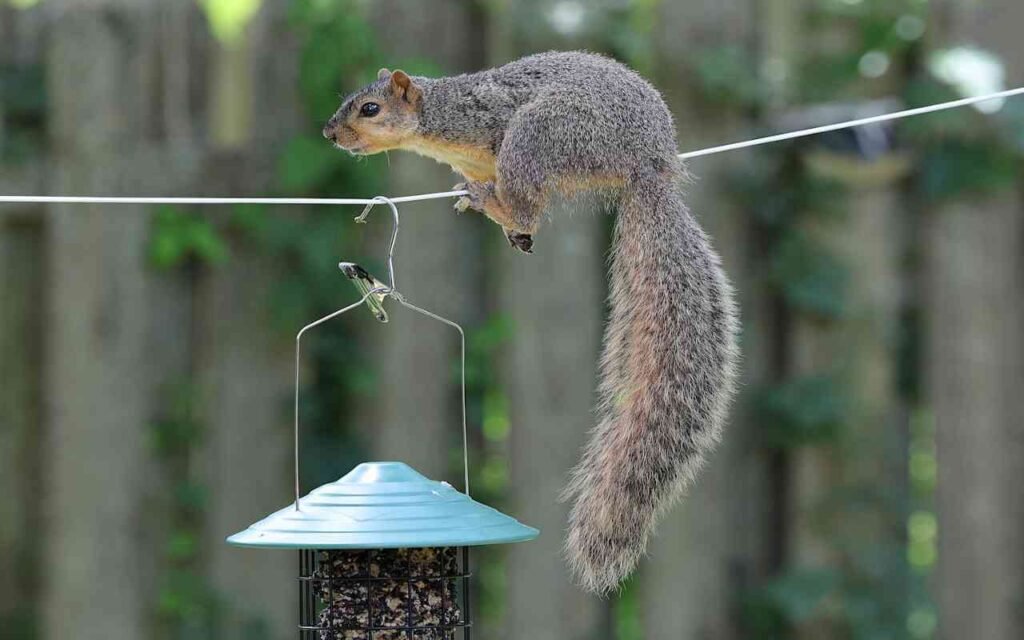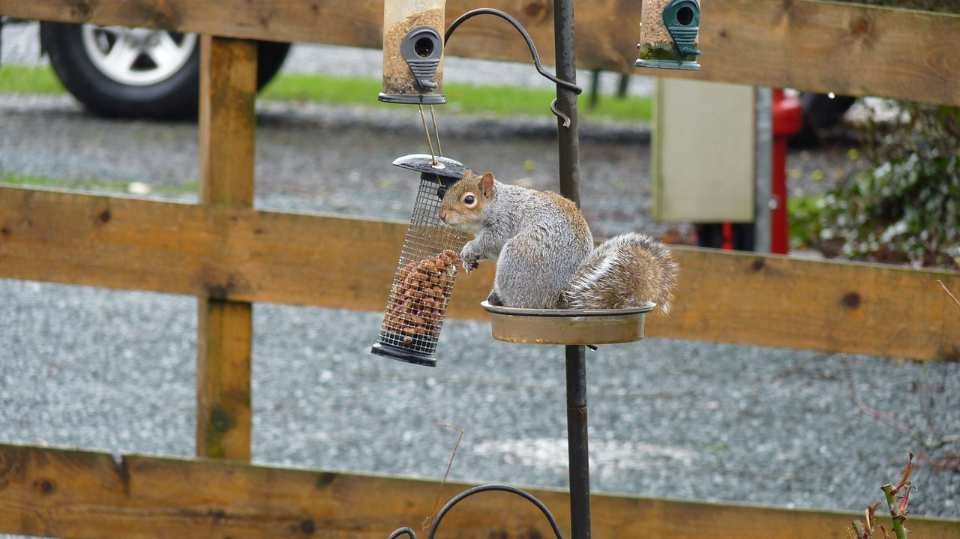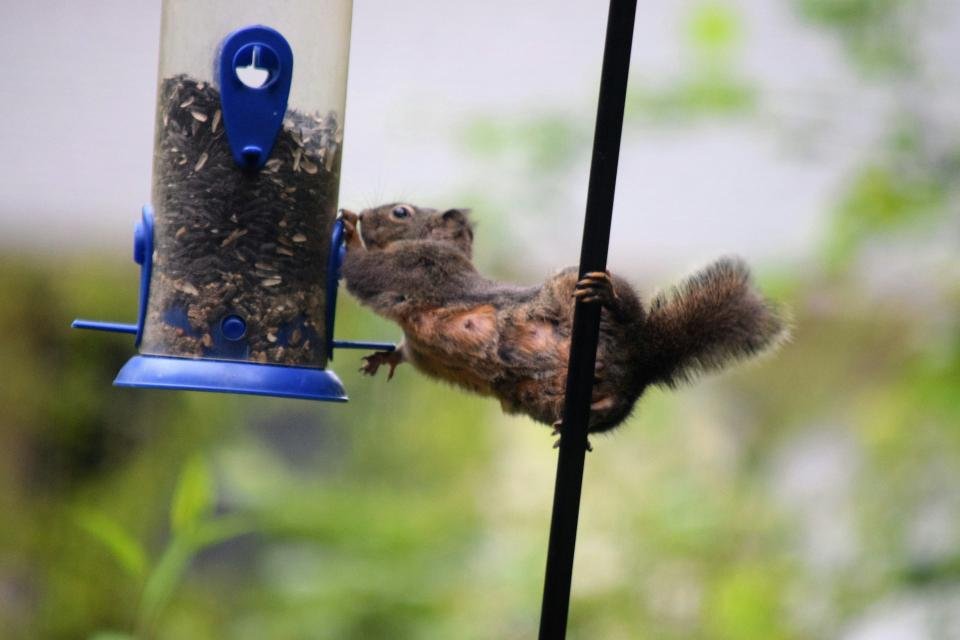You know that moment when you’re sipping your morning coffee, gazing peacefully at your beautiful bird feeder, and suddenly a furry little bandit comes swinging in like Tom Cruise in Mission Impossible 😲? Yeah, we’ve all been there. One minute you’re watching cardinals and chickadees enjoy their breakfast, the next you’re witnessing a squirrel perform death-defying acrobatics just to steal their food.
If you’ve ever wondered how to keep squirrels away from bird feeders, you’re in the right place. I’ve been feeding birds for over a decade, and let me tell you, squirrels are the ultimate bird feeder nemesis. But don’t worry, I’ve learned every trick in the book to outsmart these clever critters, and I’m about to share all my battle-tested strategies with you.
📌 Quick Answer: How to Keep Squirrels Away from Bird Feeders
- Follow the 5-4-8 Rule: Place feeders 5 feet high, 4 feet from jump points, and 8 feet from climbing surfaces.
- Use Squirrel-Proof Feeders: Weight-activated, caged, or spinning feeders stop squirrels from accessing seed.
- Add Baffles & Barriers: Dome or cylinder baffles on poles and hanging setups block climbing access.
- Try Natural Deterrents: Cayenne-treated seed, marigolds, mint, or daffodils can discourage squirrels.
- Consider Decoys: A separate squirrel feeder with peanuts or corn can divert them away from bird feeders.
Why Squirrels Are So Obsessed with Bird Feeders
Before we jump into the solutions, let’s talk about why these little gymnasts are so determined to raid your feeders. Squirrels are opportunistic feeders, and bird seed is basically a five-star buffet to them. Sunflower seeds, nyjer seeds, and suet are packed with fats and proteins that squirrels crave, especially during colder months. According to Perky Pet, squirrels are highly adaptable omnivores and will seek out bird feeders when natural food is scarce (source).
Plus, squirrels are incredibly intelligent. They can remember food sources for months and will keep returning to your yard if they’ve had success before. Ever notice how they seem to have a mental map of every feeder in the neighborhood? That’s because they literally do.
The real kicker? Squirrels can jump up to 10 feet horizontally and 5 feet vertically. They’re also excellent climbers and can hang upside down while eating. Basically, they’re furry little ninjas with an insatiable appetite for bird food.
The 5-4-8 Rule: Your First Line of Defense
Here’s the golden rule every bird enthusiast should know: the 5-4-8 rule. This simple formula is your foundation for squirrel-proof bird feeding:
- Place feeders at least 5 feet high from the ground
- Position them 4 feet away from any horizontal jumping point
- Keep them 8 feet away from any vertical climbing surface
I learned this rule the hard way after watching a particularly athletic squirrel launch itself from my deck railing like it was competing in the Olympics. Following this spacing guideline immediately cut down on about 80% of my squirrel problems. Birdfy also points out that proper feeder placement is often the most effective first step in preventing squirrel raids (source).
But here’s the thing, this rule works best when combined with other deterrent methods. Think of it as your first layer of defense, not your only one.
Squirrel-Proof Feeder Designs That Actually Work
Weight-Activated Feeders
Weight-activated feeders are absolute game-changers. These clever devices have a mechanism that closes feeding ports when something heavier than a bird lands on the perch. Most birds weigh between 0.5 to 3 ounces, while squirrels typically weigh 12-24 ounces.
That weight difference is exactly what makes these feeders so effective, you’re basically using physics to outsmart a squirrel. Wild Birds Unlimited confirms that weight-sensitive feeders allow small songbirds to feed safely while excluding heavier mammals like squirrels (source).
I’ve been using a weight-activated tube feeder for three years now, and it’s been incredibly effective. The first time I watched a squirrel trigger the mechanism and get gently pushed away, I actually laughed out loud. It’s like the feeder is saying, “Nice try, buddy!”
Caged Feeders
Caged bird feeders surround your seed dispenser with a wire cage that allows small birds in but keeps squirrels out. The spacing between the wires is crucial, too wide and squirrels will squeeze through, too narrow and larger birds can’t access the food.
Look for cages with 1.5-inch wire spacing. This allows most songbirds to enter while blocking squirrels and larger nuisance birds like grackles.
Spinning Feeders
Now these are entertaining! Spinning feeders have a motorized perch that starts rotating when a squirrel’s weight is detected. I have to admit, watching a squirrel get gently spun off a feeder never gets old 🙂
The Yankee Flipper is probably the most famous spinning feeder, and for good reason, it works. Just make sure you position it where the spinning squirrel won’t crash into anything (learned that one from experience).
DIY Squirrel Deterrents You Can Make Today
The Baffle System
Pole baffles are your best friend for ground-mounted feeders. These dome or cylinder-shaped guards prevent squirrels from climbing up the pole. You can buy commercial baffles, but I’ve made effective ones using large plastic bowls or PVC pipe.
For hanging feeders, try a hanging baffle above the feeder. I use an old metal mixing bowl turned upside down, works like a charm and cost me nothing. According to All About Birds, installing pole baffles is one of the most reliable ways to prevent squirrels from climbing feeders.
Slippery Pole Modifications
Here’s a trick that works surprisingly well: make your feeder pole too slippery to climb. You can wrap the pole in PVC pipe or apply a thin layer of petroleum jelly (though you’ll need to reapply this regularly).
Some people use cooking oil, but I don’t recommend it, it can damage squirrel fur and isn’t great for the environment.
Natural Squirrel Repellents
Spicy Seed Mixes
Birds can’t taste capsaicin (the compound that makes peppers hot), but mammals sure can! Cayenne pepper-treated bird seed is completely safe for birds but will send squirrels running. Research from Wild Birds Unlimited shows that treating seeds with cayenne pepper is an effective, bird-safe method to deter squirrels.
You can buy pre-treated seed or make your own by mixing regular bird seed with cayenne pepper powder. I use about 1 tablespoon of pepper per pound of seed.
Strategic Plant Placement
Certain plants naturally repel squirrels. Marigolds, mint, and daffodils all have scents that squirrels dislike. I planted marigolds around my feeder area last spring, and while it didn’t eliminate squirrels completely, it definitely reduced their visits.
Just remember, what works in my yard might not work in yours. Squirrels in different areas can have varying preferences and tolerances.
Advanced Squirrel-Proofing Strategies
The Decoy Feeder Method
This might sound counterintuitive, but hear me out: set up a separate feeding station just for squirrels. Place it far from your bird feeders and fill it with cheaper food like cracked corn or peanuts.
I was skeptical about this approach, but it actually works pretty well. Most squirrels will take the path of least resistance to the easiest food source. FYI, you’ll need to keep the squirrel feeder consistently stocked, or they’ll return to raiding your bird feeders.
Motion-Activated Deterrents
Motion-activated sprinklers can be effective squirrel deterrents, though they might also startle your birds initially. The key is positioning them to target squirrel approach routes without spraying the feeding area directly.
I tried this method one summer, and while it worked for squirrels, it also soaked the mailman twice. Oops.
Timing Your Feeding
Squirrels are most active in early morning and late afternoon. If you’re willing to be strategic about when you fill your feeders, you can time it for peak bird activity periods when squirrels are less likely to be around.
This requires more effort, but it’s surprisingly effective for reducing squirrel interference.
Common Mistakes to Avoid
Placing Feeders Too Close to Launch Points
The biggest mistake I see people make is underestimating squirrel jumping ability. That tree branch that looks “far enough away”? It’s probably not. Squirrels are better jumpers than most people realize.
Using Feeders Without Weight Limits
Not all “squirrel-proof” feeders are created equal. Some cheap knockoffs have weight mechanisms that are too sensitive (closing for large birds) or not sensitive enough (allowing squirrels access).
Neglecting Ground Cleanup
Spilled seed on the ground attracts squirrels just as much as feeders do. Regular cleanup under your feeders removes this attraction and reduces overall squirrel traffic in your yard.
I learned this lesson when I noticed squirrels spending more time foraging under my feeders than trying to access them. A simple rake and broom routine solved the problem.
Maintenance and Long-Term Success
Regular Equipment Inspection
Squirrel-proofing isn’t a “set it and forget it” solution. Check your equipment regularly for damage or wear. Squirrels can chew through surprising materials, and weather can compromise baffles and other deterrents.
Adapting to Squirrel Behavior
Here’s something most articles won’t tell you: squirrels learn and adapt. A method that works perfectly for six months might suddenly become ineffective as local squirrels figure out workarounds.
Stay observant and be ready to switch up your tactics. I keep multiple types of deterrents on rotation, which keeps the squirrels guessing.
Seasonal Considerations
Winter months often see increased squirrel activity at feeders as natural food sources become scarce. According to wildlife experts at Skedaddle, supplemental feeding is especially important during winter, when squirrels rely more heavily on backyard food sources. You might need to double down on your deterrent methods during colder months.
Spring brings breeding season, which can make squirrels more territorial and persistent. Pregnant females especially need high-energy foods and may be more determined to access your feeders.
When to Call It a Draw
Sometimes, despite your best efforts, you’ll encounter that one super-squirrel who defeats every deterrent you throw at them. I had one particularly clever gray squirrel that figured out how to defeat three different “squirrel-proof” systems.
At that point, you have two choices: escalate to more expensive/complex deterrents, or appreciate the entertainment value and accept that you’re feeding some very athletic squirrels along with your birds.
IMO, there’s something to be said for the latter approach. These little acrobats are pretty amazing creatures, even if they are bird seed thieves.
Final Thoughts
Keeping squirrels away from bird feeders is part science, part art, and part ongoing battle of wits. The key is using multiple strategies simultaneously and staying flexible as you learn what works in your specific situation.
Remember, there’s no such thing as a 100% squirrel-proof system, but you can definitely tip the odds in favor of your feathered friends. Start with proper feeder placement, invest in quality squirrel-resistant equipment, and don’t be afraid to get creative with your approach.
The most important thing? Don’t let squirrel frustration rob you of the joy of bird feeding. Those moments when a cardinal lands on your feeder or you spot a new species in your yard make all the squirrel shenanigans worth it.
Happy bird feeding, and may the odds be ever in your favor against those furry little bandits!




